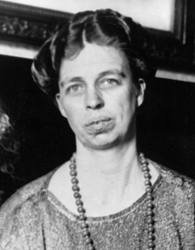Eleanor Roosevelt was more than just a first lady. She was a politician in her own right, serving on the United Nations, promoting the New Deal and setting off second-wave feminism with her insistence that she—and all other women—be treated as equal to men.
Eleanor Roosevelt’s Early Days
Born Anna Eleanor Roosevelt on October 11, 1884, in New York City, the future first lady spent her early childhood clamoring for her mother’s attention. Her mother, Anna, a member of New York’s high society, rejected her daughter for her plain looks. In response, she clung to her father Elliott, who graced her with some of the only affection she experienced.
When she was eight years old, Roosevelt’s mother died from diphtheria. Instead of living with her father, who had spent time in a sanitarium and who still struggled with alcohol abuse, Roosevelt and her two brothers were sent to live with their maternal grandmother. Within two years of her mother’s death, one of Roosevelt’s brothers and her father had passed away, as well. At 15, Roosevelt was sent to an English girls’ boarding school.
Upon her return to New York, Roosevelt made her “debut” in society, a process that aggravated her insecurities about her looks and graces. She busied herself working with the poor, teaching in tenement houses and advocating on a consumers’ league. During her coming-out ball, her fifth cousin Franklin D. Roosevelt was fascinated by her work with the poor and soon after, the pair began a courtship.
Sources in this Story
- National First Ladies’ Library: First Lady Biography: Eleanor Roosevelt
- National Park Service: Eleanor Roosevelt and the Women’s Movement
- George Washington University: The Eleanor Roosevelt Papers Project: Anna Eleanor Roosevelt
- George Washington University: The Eleanor Roosevelt Papers Project: “First Lady of the World”
- Library of Congress: President Franklin Delano Roosevelt and the New Deal 1933-1945
- PBS American Experience: Eleanor Roosevelt: My Day
Roosevelt’s Notable Accomplishments
In March 1905, the 20-year-old Eleanor Roosevelt married Franklin Delano Roosevelt. During the early years of the marriage, Roosevelt busied herself with raising her children; the pair had six, one of whom died soon after his birth. Although her husband was becoming politically active—he was elected in 1910 to the state senate—Roosevelt herself was as yet fairly unaware of the political climate.
In the 1920s Roosevelt began to take an interest in politics and the women’s suffrage movement, realizing how little a say women truly had in the laws and policies that governed their lives.
When her husband became paralyzed from polio in 1921, Roosevelt began—under her husband’s tutelage—to move more fluidly through political circles. She became adept at judging social and political climates so she could then report back to her paraplegic husband.
During FDR’s successful bids for governor of New York in 1928 and U.S. president in 1932, Roosevelt was by his side, campaigning and stumping across the country. Once her husband was in the Oval Office, she revolutionized the post of first lady: instead of running the domestic operations of the White House, she traveled the world, acting as a diplomat and speaking in favor of marginalized populations. She also worked as a strong proponent of the New Deal, a series of programs designed to help the country recover from the Great Depression.
During World War II, Roosevelt expanded the scope of her work to include visits to injured soldiers on the front and brought back stories of the conflict to her husband in Washington, D.C. After he passed away in 1945, Roosevelt’s mourning for her husband still did not slow her down.
Roosevelt was appointed by Harry S. Truman to head the United Nations Human Rights Commission in 1945, where she was instrumental in drafting the Declaration of Human Rights. She was also active in the NAACP, the League of Women Voters and the Democratic Party. She also continued to write a syndicated daily column, My Day, which she penned on 8,000 days between 1935 and 1962.
Eleanor Roosevelt and her Work
- “You Learn by Living”
- “My Day: The Best of Eleanor Roosevelt’s Acclaimed Newspaper Columns, 1936-1962”
- “The Autobiography of Eleanor Roosevelt”
The Rest of the Story
One of the chief causes of conflict in Roosevelt’s life was the other women in her husband’s world. At the onset of her marriage, it was his mother, Sara, who dominated their household: she chose their home, hired their staff and dictated most of Eleanor and Franklin’s day-to-day life.
Nearly as soon as they’d gotten out from under the thumb of Sara, Roosevelt had another woman to contend with: her husband’s mistress Lucy Page Mercer. Upon learning of the affair, Eleanor offered Franklin a divorce. Instead, at the insistence of his mother, he promised never to see Mercer again. On the day of his death, Roosevelt found that Franklin had resumed his relationship with Mercer and was with her when he died in Warm Springs, Georgia.
Eleanor Roosevelt died November 7, 1962, at the age of 78 from complications of tuberculosis.
This article was originally written by Jennifer Ferris; it was updated October 15, 2017.











